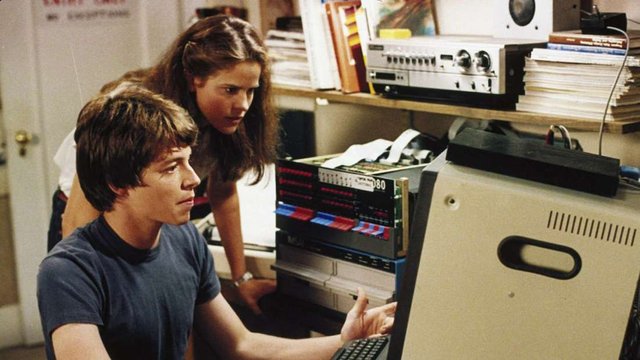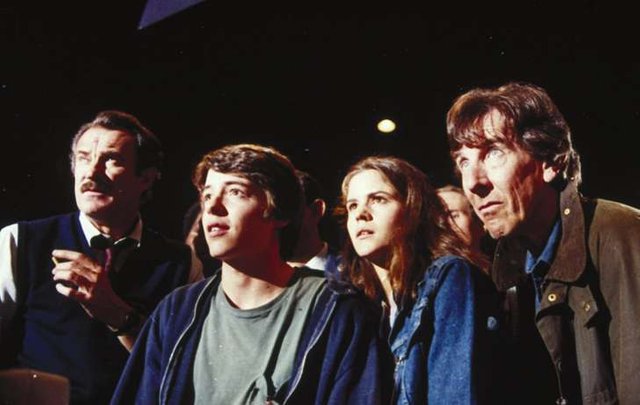war game

In the late 1970s, two screenwriters had an idea about a precocious young genius and an older genius who would serve as his mentor, and decided to do some research to turn it into a story. That led them to the burgeoning new world of personal computing and hacking in the midst of Cold War America. That new world, coupled with the original idea, became WarGames.
Though it remains a classic 35 years after its original 1983 release, the road to the big screen was a hard one for WarGames. After the initial idea took a while to evolve into what the final film became, the production faced studio executives who just didn’t understand what they were trying to do, worries over an implausible plot, fired and rehired writers, and a director change just days into filming. Ultimately, though, a talented cast and crew—including breakout stars Matthew Broderick and Ally Sheedy—produced a hit thriller that remains both beloved and influential more than a quarter century after its release.
So, to celebrate its 35th birthday, who are 15 things you might not know about WarGames.
- THE ORIGINAL IDEA WASN’T ABOUT COMPUTERS OR HACKING.
Before it became a story that blended the rise of hackers and personal computing with the ongoing threats of the Cold War, WarGames was an idea called The Genius. It began when co-writer Lawrence Lasker saw a TV documentary that featured Stephen Hawking. Lasker became fascinated by the idea that Hawking’s work could lead him to essentially solve all the mysteries of the universe, but his ALS might prevent him from even being able to share that knowledge. Lasker saw an opportunity for a story that would pair a Hawking-like older genius, in a wheelchair, with a precocious teenage genius still looking for his place in the world, and took that idea to Walter F. Parkes, an old college roommate.
“I found the predicament Hawking was in fascinating—that he might one day figure out the unified field theory and not be able to tell anyone, because of his progressive ALS," Lasker told WIRED. "So there was this idea that he'd need a successor. And who would that be? Maybe this kid, a juvenile delinquent whose problem was that nobody realized he was too smart for his environment. That resonated with Walter. So I said, let's actually go talk to people about how a kid could get in trouble and get discovered by a brainy scientist and take it from there.”
With the blessing of executive producer Leonard Goldberg, who was intrigued by the idea, Lasker and Parkes embarked on a period of research in 1979 that eventually led them to futurist Peter Schwartz at the Stanford Research Institute. After hearing the story idea, Schwartz made a connection between brilliant young kids playing computer games and experimenting with hacking, and bright adults working in environments like NORAD, looking at radar screens and missile targeting displays. That led Lasker and Parkes down a new research road that ultimately also included the rise of home computers. After a few different permutations, the story that ultimately became WarGames was born.
- REAL EARLY HACKERS SERVED AS MODELS FOR DAVID LIGHTMAN.
After they became convinced that the world of computers and hacking would be a great way to get their young genius into the kind of trouble that would drive a movie, Lasker and Parkes began researching the world of hacking and phone phreaks, and ultimately consulted with real-life hackers on the film. These included John “Captain Crunch” Draper, who discovered that a whistle given away as a prize in a cereal box could be used to activate a phone line, thus giving him free phone calls, and David Scott Lewis, who spent his days finding ways around then-primitive computer security measures.
“Hacking was easy back then," Lewis said. "There were few if any security measures. It was mostly hackers versus auditing types. The Computer Security Institute comes to mind. I would read all of their materials and could easily find ways around their countermeasures. The part in the movie showing David Lightman perusing the library to find Falken's backdoor password, ‘Joshua,’ is clearly a reference to many of my antics.”
Lasker and Parkes poured the tricks they learned from these hackers—including the idea at the end of the film to set the number of players in Joshua’s tic-tac-toe game to “zero”—into the film, thus forming David Lightman.

- DR. FALKEN WAS BASED ON STEPHEN HAWKING, AND WAS SUPPOSED TO BE PLAYED BY JOHN LENNON.
Matthew Broderick, Ally Sheedy, Dabney Coleman, and John Wood in WarGames (1983)
METRO-GOLDWYN-MAYER STUDIOS INC.
Even as the story evolved from a film about an older genius passing his wisdom on to a young protégé into a film about a teen hacker accidentally playing Global Thermonuclear War, Lasker and Parkes held on to the idea that the Dr. Stephen Falken character would be based heavily on Stephen Hawking. They envisioned him as a dying genius still holding on to a few secrets, and even wrote the character as using a motorized wheelchair. In thinking of who they might cast to play this kind of mythic persona, Lasker and Parkes had a very clear idea: John Lennon, whom Parkes described as a kind of “spiritual cousin” to Hawking. That plan, of course, had to be set aside when Lennon was shot and killed by Mark David Chapman on December 8, 1980.
“And through David Geffen, we'd communicated with John Lennon, and he was interested in the role,” Lasker recalled. “I was writing the first scene where we meet Hawking—Falken—in the movie. He was an astrophysicist in our second draft. I was staring at the cover of the November 1980 issue of Esquire, with Lennon on the cover, and describing his face, when a friend of mine—a bit of a jerk—called and said, 'You're gonna have to find a new Falken.'"
The role of Dr. Falken ultimately went to veteran English actor John Wood. As for the wheelchair: Original director Martin Brest ditched the idea, because he thought having a famous scientist in a motorized wheelchair in the war room scenes would remind audiences of Dr. Strangelove a bit too much.